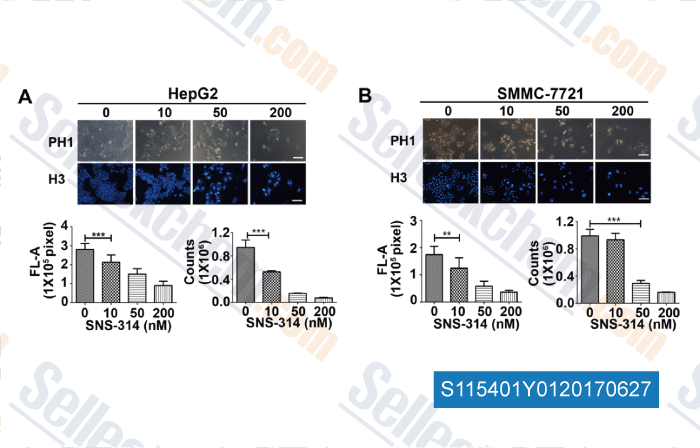|
Toll Free: (877) 796-6397 -- USA and Canada only -- |
Fax: +1-832-582-8590 Orders: +1-832-582-8158 |
Tech Support: +1-832-582-8158 Ext:3 Please provide your Order Number in the email. |
Technical Data
| Formula | C18H15ClN6OS2 |
|||
| Molecular Weight | 430.93 | CAS No. | 1057249-41-8 | |
| Solubility (25°C)* | In vitro | DMSO | 105 mg/mL (243.65 mM) | |
| Water | 6 mg/mL (13.92 mM) | |||
| Ethanol | Insoluble | |||
|
* <1 mg/ml means slightly soluble or insoluble. * Please note that Selleck tests the solubility of all compounds in-house, and the actual solubility may differ slightly from published values. This is normal and is due to slight batch-to-batch variations. * Room temperature shipping (Stability testing shows this product can be shipped without any cooling measures.) |
||||
Preparing Stock Solutions
Biological Activity
| Description | SNS-314 is a potent and selective inhibitor of Aurora A, Aurora B and Aurora C with IC50 of 9 nM, 31 nM, and 3 nM, respectively. It is less potent to Trk A/B, Flt4, Fms, Axl, c-Raf and DDR2. Phase 1. | ||||||
|---|---|---|---|---|---|---|---|
| Targets |
|
||||||
| In vitro | In HCT116 colorectal carcinoma cell line, with intact or depleted p53 protein levels, SNS-314 Mesylate shows enhanced efficacy when administered sequentially with other standard chemotherapeutic agents and the most profound synergies are identified for agents that activate the spindle assembly checkpoint. [2] A recent study shows that SNS-314 Mesylate shows potent antiproliferative activity in HCT116 cells and inhibits soft agar colony formation. [3] |
||||||
| In vivo | The sequential treatment with SNS-314 Mesylate 24 hours later produces a significant 72.5% tumor growth inhibition of HCT116 xenografts, while SNS-314 Mesylate as single agents produce no significant inhibition of HCT116 tumor growth. [2] In the HCT116 human colon cancer xenograft model, administration of 50 and 100 mg/kg SNS-314 Mesylate results a dose-dependent inhibition of histone H3 phosphorylation, indicating effective Aurora-B inhibition in vivo. In addition, HCT116 tumors from animals treated with SNS-314 Mesylate exhibits potent and sustained responses including reduction of phosphorylated histone H3 levels, increased caspase-3 and appearance of increased nuclear size. [3] |
Protocol (from reference)
| Kinase Assay: |
|
|---|---|
| Cell Assay: |
|
| Animal Study: |
|
References
Customer Product Validation

-
Data from [Data independently produced by Exp Cell Res, 2012, 318(4), 336-49]

-
Data independently produced by , , Dr. Zhang of Tianjin Medical University

-
Data from [Data independently produced by , , Oncotarget, 2017, 8(17):27953-27965]
Selleck's SNS-314 has been cited by 11 publications
| DELs enable the development of BRET probes for target engagement studies in cells [ Cell Chem Biol, 2023, 30(8):987-998.e24] | PubMed: 37490918 |
| The multi-kinase inhibitor CG-806 exerts anti-cancer activity against acute myeloid leukemia by co-targeting FLT3, BTK, and Aurora kinases [ Res Sq, 2023, rs.3.rs-2570204] | PubMed: 36865133 |
| Concomitant targeting of FLT3 and BTK overcomes FLT3 inhibitor resistance in acute myeloid leukemia through inhibition of autophagy [ Haematologica, 2022, 10.3324/haematol.2022.280884] | PubMed: 36226489 |
| Dual Inhibition of AKT and MEK Pathways Potentiates the Anti-Cancer Effect of Gefitinib in Triple-Negative Breast Cancer Cells [ Cancers (Basel), 2021, 13(6)1205] | PubMed: 33801977 |
| Intratumoural Heterogeneity Underlies Distinct Therapy Responses and Treatment Resistance in Glioblastoma. [ Cancers (Basel), 2019, 11(2)] | PubMed: 30736342 |
| Targeted Polo-like Kinase Inhibition Combined With Aurora Kinase Inhibition in Pediatric Acute Leukemia Cells. [ J Pediatr Hematol Oncol, 2019, 41(6):e359-e370] | PubMed: 30702467 |
| Targeting high Aurora kinases expression as an innovative therapy for hepatocellular carcinoma. [Liu F, et al. Oncotarget, 2017, 8(17):27953-27965] | PubMed: 28427193 |
| The aurora kinase inhibitor VX-680 shows anti-cancer effects in primary metastatic cells and the SW13 cell line [Wang J, et al. Invest New Drugs, 2016, 10.1007/s10637-016-0358-3] | PubMed: 27177645 |
| Aurora Kinases as Druggable Targets in Pediatric Leukemia: Heterogeneity in Target Modulation Activities and Cytotoxicity by Diverse Novel Therapeutic Agents [Jayanthan A, et al. PLoS One, 2014, 9(7):e102741] | PubMed: 25048812 |
| Targeting Sonic Hedgehog-Associated Medulloblastoma through Inhibition of Aurora and Polo-like Kinases. [Markant SL, et al. Cancer Res, 2013, 73(20):6310-22] | PubMed: 24067506 |
RETURN POLICY
Selleck Chemical’s Unconditional Return Policy ensures a smooth online shopping experience for our customers. If you are in any way unsatisfied with your purchase, you may return any item(s) within 7 days of receiving it. In the event of product quality issues, either protocol related or product related problems, you may return any item(s) within 365 days from the original purchase date. Please follow the instructions below when returning products.
SHIPPING AND STORAGE
Selleck products are transported at room temperature. If you receive the product at room temperature, please rest assured, the Selleck Quality Inspection Department has conducted experiments to verify that the normal temperature placement of one month will not affect the biological activity of powder products. After collecting, please store the product according to the requirements described in the datasheet. Most Selleck products are stable under the recommended conditions.
NOT FOR HUMAN, VETERINARY DIAGNOSTIC OR THERAPEUTIC USE.
